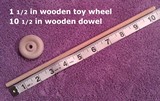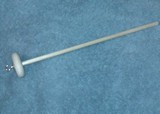Although this information is easily available, I still see lots of questions about how to make a hand spindle for spinning Angora rabbit fiber. It seems to me that the answers given to the questions, whether on forums or social media, are often unnecessarily complicated. I have even made a spindle from an ink pen while at a rabbit show, which shows how simple it can be.
Because Angora is fine, light and fluffy, your hand spindle should be small and light.To get started, all you need is a 1/4 inch diameter dowel rod, and 1 1/2 inch diameter wooden toy wheel. These can be found at craft stores such as Hobby Lobby or Ben Franklin. (Click on the thumbnails below to view larger images.)
To begin spinning, you will need some yarn to start it off. If you don’t have any yarn or string handy, just rub and roll some Angora fiber until you have a piece of yarn that is about 14 inches long. Angora “wants” to spin! You can also take any piece of thread, string, or yarn, tie it into a loop, then put it onto your spindle as a starter for your yarn.
Tie the end to the base of the long side of the dowel, then put the yarn around the shorter dowel section, and from there run it to the end of the long section and loop it so that it will not come loose.
If you are right handed, hold the yarn and some Angora fluff in your left hand, and spin the spindle like a top, clockwise, with your right hand and then release it. While the spindle spins, you can use both hands to draft the fiber as it is wrapped into single ply yarn by the spindle’s action.
After you have spun about a yard of yarn, then you remove the loop from the tip of the spindle, unloop the yarn from the spindle on the other end, and wrap the yarn around the spindle. Leave about 12 inches of yarn unwrapped, so you can use it to loop around the bottom dowel end again, and loop the upper end again to spin some more.
When you have filled your spindle with single ply yarn, you are ready to “ply” it. Until 2 or 3 single plies are plied together, your yarn will not be strong enough to use for knitting. A simple method of plying are the “chain plying” or “Navajo plying” methods, some easier than others. For beginners, it may be easier to chain play the yarn to a second spindle from the first.
The final step is to wash or perform the “fulling” of your new yarn. Make your plied yarn into a skein and lightly tie in 2-4 places so it won’t become tangled during the “fulling” process. Wash the skein in warm water with a dab of Dawn dish soap. You may want to add a dab of Oxyclean to the water. Very gently press excess air from the skein while it is under water. Let it soak in the water for 2-5 minutes. Get a dish of cold water with a dab white vinegar added, and place the yarn into it. Let the skein soak for another 2-5 minutes. Next, give the skein one more plain warm water rinse. Carefully squeeze the water out of the skein and then roll it in a towel, getting it as dry as possible.
Next, grasp the skein and give it a good whack against your counter a couple of times. The objective is to “bloom” the yarn, so that it acquires the distinctive Angora halo. Then let it finish drying, and it will be ready for use.
There are many articles and videos on the internet that explain the finer points of spinning with a hand (drop) spindle. I find hand spindles appealing because they are easy and cheap to make, and are easy to take along for spinning almost anywhere. There used to be an annual folklife festival in my hometown, and my friend Cheri would set up to demonstrate fiber arts, with Angora rabbits, there. My contribution was to sell “spinning starter kits” which were bags that each held some Angora wool and a small hand spindle. This may be something you would also like to do if you give fiber arts demonstrations.




